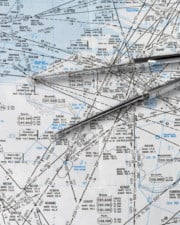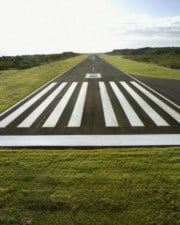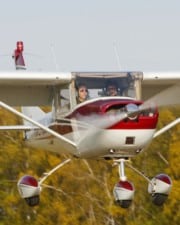Aeromedical factors are the study of how the human body works when flying a plane. Quite a few things change for our bodies once our feet leave the ground. Perhaps one of the most apparent challenges we face at altitude is the reduced amount of oxygen.
Table of Contents
What is Hypoxia?
Hypoxia is simply the medical term for oxygen deprivation in the body. It can come from a variety of factors, but it is especially crucial for aviators to consider since the amount of oxygen available in the atmosphere decreases as altitude increases.
There are four types of hypoxia, but their signs and symptoms are the same. All four result from oxygen being unable to reach or be used by the body’s organs. Without enough oxygen, the body will lose consciousness.
To operate at higher altitudes, pilots of small aircraft carry supplemental oxygen. This is usually carried in a small portable tank and fed to the pilot via a cannula. Some airplanes even have oxygen systems integrated into the plane. These systems work fine for piston-driven planes that can’t operate much above 12,000 feet MSL anyway.
Jet, turboprop, and some turbocharged aircraft are pressurized so that they can operate at very high altitudes. Flying in these planes means that you don’t have to use the oxygen tank all the time, but it must be aboard nonetheless for use in the event of an emergency.
All of this means that pilots should be especially cautious of hypoxia onset in two specific scenarios. In small aircraft, they should be aware that gradual and progressive hypoxia can occur anytime they are operating above 10,000 feet MSL. Another hazardous situation occurs anytime there is a rapid decompression event in a pressurized aircraft.
Aeromedical factors, including the dangers of hypoxia, are covered in the FAA’s Pilot’s Handbook of Aeronautical Knowledge, Chapter 17.
Four Types of Hypoxia
Depending on how the condition develops, there are four ways that the body can get insufficient oxygen. All of these play some factor in the lives of aviators.
Hypoxic hypoxia
Hypoxic hypoxia is the result of there not being enough oxygen in the air. This happens when flying an airplane too high without supplemental oxygen, or when climbing a tall mountain. To prevent it, pilots are required to use oxygen above certain altitudes.
Pressurized aircraft are designed to keep the air pressure (and therefore the oxygen levels) inside the cabin equal to lower altitudes. This enables the plane to fly much higher than the pilots and passengers could, without everyone having to use oxygen all the time.
Hypemic hypoxia
Hypemic hypoxia results from the body’s red blood cells being unable to carry oxygen to the organs. In medicine, it is caused by severe blood loss or anemia. A possible cause of this in aviation is carbon monoxide poisoning.
Carbon monoxide is a deadly colorless, odorless, and tasteless gas that is created by internal combustion engines. Usually, exhaust gasses should be vented overboard and be no factor. But carbon monoxide can make its way into the cabin in piston aircraft by way of a damaged heater.
Carbon monoxide detectors are essential pieces of equipment on light aircraft for this reason.
Histotoxic hypoxia
Lack of oxygen can also occur when the body’s tissues are being affected by other substances. Drugs and alcohol can cause the organs not to use sufficient oxygen. While the effects may be negligible at the surface, at altitude they may be significantly amplified. When combined with one of the other sources of hypoxia, histotoxic hypoxia can quickly incapacitate a person.
For this reason, pilots should clear all medications they use with their flight doctors. Even over-the-counter drugs can have surprisingly dramatic effects at altitude. It is also part of the reason that regulators and employers take a hard stance against pilots drinking any time before flights.
Stagnant hypoxia
It’s also possible for the blood to not flow enough to feed the organs all of the oxygen they need. On the ground, this could be caused by cardiovascular disease. In flight, this is commonly caused by G-forces.
As an aircraft pulls more G’s, the heart and cardiovascular system must work harder to keep blood flowing to the head and brain. The increased pull of gravity will make it harder and harder to do.
Eventually, this will lead to tunnel vision as the eyes receive insufficient oxygen, and then grey out and blackout. For pilots of fighter planes and high-G aircraft, special flight suits apply pressure on the limbs to help the body keep blood flowing. Pilots are also trained and conditioned to operate at higher G-forces.

Symptoms of Hypoxia
One of the biggest challenges in dealing with hypoxia during flight is that the effects are not always evident at first. This, coupled with the fact that its effects are cumulative, makes it difficult to recognize.
The initial effects of hypoxia are not unlike alcohol. A feeling of carefree euphoria is sometimes the first signal that something’s wrong. Other signs include blue fingernails or lips, headache, delayed response times, or impaired judgment.
As the body’s tissues become more and more starved for oxygen, numbness, tingling fingers and toes, drowsiness, and lightheadedness will follow. The field of vision will narrow, and unconsciousness follows.
The Four Stages of Hypoxia
As the body gets less oxygen, hypoxia progresses through four stages.
The first stage, the Indifferent Stage, really only affects one part of the body–the eyes. The process of dark adaptation is extremely oxygen intensive. As a result, eyesight is severely limited at night if there is low oxygen available. This is the reason that the FAA recommends supplemental oxygen above 5,000 feet MSL at night.
The second stage is the Compensatory Stage. During this phase, the body automatically attempts to make up for the lack of oxygen by increasing the breathing rate or taking deeper breaths.
Next comes the Disturbance Stage, where the body can no longer make up for the lack of oxygen, and signs and symptoms listed above can become evident.
The final stage of hypoxia is the Critical Stage, where consciousness is lost, and death follows shortly after that.
Solutions for Hypoxia
There are only two fixes for hypoxia, and both solutions involve increasing the amount of oxygen available to the body. The first step for pilots to take is to reduce the flight altitude. The second step is to use supplemental oxygen, if possible.
The Federal Aviation Regulations (FARs) lay out when pilots must use supplemental oxygen. FAR Part 91.211 states:
In flights that operate above 12,500 feet MSL, the flight crew must use supplemental oxygen for all times at those altitudes after 30 minutes.
Once above 14,000 feet MSL, the flight crew must use supplemental oxygen.
For flights operating above 15,000 feet MSL, all passengers must also be provided with oxygen.
These are the regulations affecting oxygen use for unpressurized aircraft. But the FAA acknowledges that hypoxia can affect some people more dramatically than others. The FAA’s Aeronautical Information Manual recommends that supplemental oxygen be used at all times when above 10,000 feet MSL, and above 5,000 feet MSL at night.

Pressurized Aircraft
Anyone who has flown on an airliner knows that they don’t spend the flight sucking on an oxygen tube. Most jet and turboprop airplanes have pressurized cabins for the comfort of the crew and passengers.
When operating normally, the pressurization system of most planes keeps the cabin pressure at approximately 8,000 feet above sea level. On very long flights, the cumulative effects of being at even this relatively low altitude can cause mild cases of hypoxia.
Of course, the real danger of hypoxia with these planes occurs if something goes wrong, and the cabin loses pressure. The difference in pressure between the inside and the outside of the cabin is immense.

Aircraft operating at high altitudes are equipped with quick-donning masks for the flight crew to wear in an emergency. Dropdown emergency use masks are provided for the passengers.
Depressurization at altitude is a practiced emergency procedure. The first course of action is to put the aircraft into an emergency descent to a lower and safer altitude, with enough oxygen to keep everyone on board conscious.
Another concern for pressurized aircraft is the hazards associated with a gradual decompression. If the pressure leaks gradually, or the pressurization system is set incorrectly and never activates, the crew can be unaware of the emergency until it is too late.
There have even been accidents where the crew was unaware that the pressurization system was inactive until the emergency masks in the cabin dropped automatically!
Time of Useful Consciousness
Since atmospheric pressure decreases dramatically as altitude increases, the amount of useable oxygen present decreases almost exponentially. The FAA publishes the following table, describing a rough estimate of how many seconds or minutes a person can expect to remain conscious at a given altitude in the case of a sudden decompression event.
- 45,000 feet MSL–9-15 seconds
- 40,000 feet MSL–15-20 seconds
- 35,000 feet MSL–30-60 seconds
- 30,000 feet MSL–1-2 minutes
- 28,000 feet MSL–2.5-3 minutes
- 25,000 feet MSL–3-5 minutes
- 22,000 feet MSL–5-10 minutes
- 20,000 feet MSL–30 minutes or more
Related Posts













